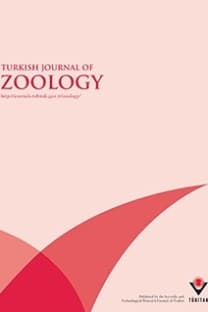Hybridisation or vocal mimicry? A case of a mixed singing River Warbler Locustella fluviatilis in eastern Poland
Key words: River Warbler, Grasshopper Warbler, vocal mimicry, hybridisation
Hybridisation or vocal mimicry? A case of a mixed singing River Warbler Locustella fluviatilis in eastern Poland
___
- Bergmann, H.H. and Helb, H.W. 1982. Stimmen der Vögel Europas: Gesänge und Rufe von über 400 Vogelarten in mehr als 2000 Sonagrammen. BLV Verlagsgesellschaft, Munich (in German).
- Bruun, J.E., Hanhela, M. and Hanhela, H. 1995. Suomen Luonto. Weilin+Göös, Linnut (in Finnish).
- Celmins, A., Folkmanis, I., Kurochkin, A., Litavnieks, J., Racinskis, E., Pranks, V. and Rozners, G. 2012. Latvian Birding. Bird Songs & Calls. Available at www.putni.lv.
- Cramp, S. 1998. The Complete Birds of the Western Palearctic on CD-ROM. Oxford University Press, Oxford.
- Deregnaucourt, S., Mitra, P.P., Fehér, O., Maul, K.K., Lints, T.J. and Tchernichovski, O. 2004. Song development: in search of the error-signal. Ann. NY Acad. Sci. 1016: 364–376.
- Génsbİl, B. 1998. Fugle stemmerne omkring os. Gads Forlag, Copenhagen (in Danish).
- Hansson, B., Roggeman, W. and De Smet, G. 2004. Molecular evidence of a reed warbler × great reed warbler hybrid (Acrocephalus scirpaceus × A. arundinaceus) in Belgium. J Ornithol 145: 159–160.
- Hansson, B., Tarka, M., Dawson, D.A. and Horsburgh, G.J. 2012. Hybridization but no evidence for backcrossing and introgression in a sympatric population of Great Reed Warblers and Clamorous Reed Warblers. PLoS ONE 7(2): e31667.
- Kelley, L.A., Coe, R.L., Madden, J.R. and Healy, S.D. 2008. Vocal mimicry in songbirds. Anim. Behav. 76(3): 521–528.
- Kennerley, P. and Pearson, D. 2010. Reed and Bush Warblers. Christopher Helm, London.
- Kettle, R. and Ranft, R. 1992. British Bird Sounds on CD. British Library Publishing, London.
- Kruszewicz, A.G. 2006. Ptaki Polski, Vol. 2. Multico Oficyna Wydawnicza, Warsaw (in Polish).
- Lemaire, F. 1977. Mixed song, interspecific competition and hybridisation in the Reed and Marsh Warblers (Acrocephalus scirpaceus and palustris). Behaviour 63: 215–240.
- Mackowicz, R. 1989. Breeding biology of the River Warbler Locustella fluviatilis (Wolf, 1810) in north-eastern Poland. Acta Zool. Cracov. 32: 331–437.
- Nottebohm, F. 2005. The neural basis of birdsong. PLoS Biology 3(5): e1
- Pałczyński, Z. 2001. Głosy ptaków Polski. Głosy Ptaków, Puszczykówko (in Polish).
- Schulze, A. and Dingler, K.H. 2007. Die Vogelstimmen Europas, Nordafrikas und Vorderasiens. Musikverlag Edition AMPLE, Germering (in German).
- Xeno-Canto Europe 2005–2012. Sharing Bird Songs from around the World. Xeno-canto Foundation. Available at www.xeno-canto. org.
- ISSN: 1300-0179
- Yayın Aralığı: 6
- Yayıncı: TÜBİTAK
Lizhou TANG, Long YU, Weidong LU, Junjie WANG, Mei MA, Xiaodong SHI
Fulya SAYGILI, Nuri YİĞİT, Pınar ÇAM, Duygu YÜCE
Michal POLAKOWSKI, Monika BRONISZEWSKA, Lukasz JANKOWIAK, Tomasz COFTA
Ayça ÖZKAN KOCA, İrfan KANDEMİR
Ground beetles (Coleoptera: Carabidae) of Azarbaijan, Iran
Gammarus baysali sp. nov., a new freshwater amphipod species from Turkey (Amphipoda: Gammaridae)
Murat ÖZBEK, Levent YURGA, Okan KÜLKÖYLÜOĞLU
Two new mite species of the genus Raphignathus Dugés (Acari: Raphignathidae) from Turkey
Lukasz JANKOWIAK, Piotr TRYJANOWSKI
Zübeyde KUMBIÇAK, Ayla KARATAŞ, Ümit KUMBIÇAK, Osman SEYYAR
Harpactea ballarini sp. nov., a new dysderid (Araneae, Dysderidae) spider from Turkey
